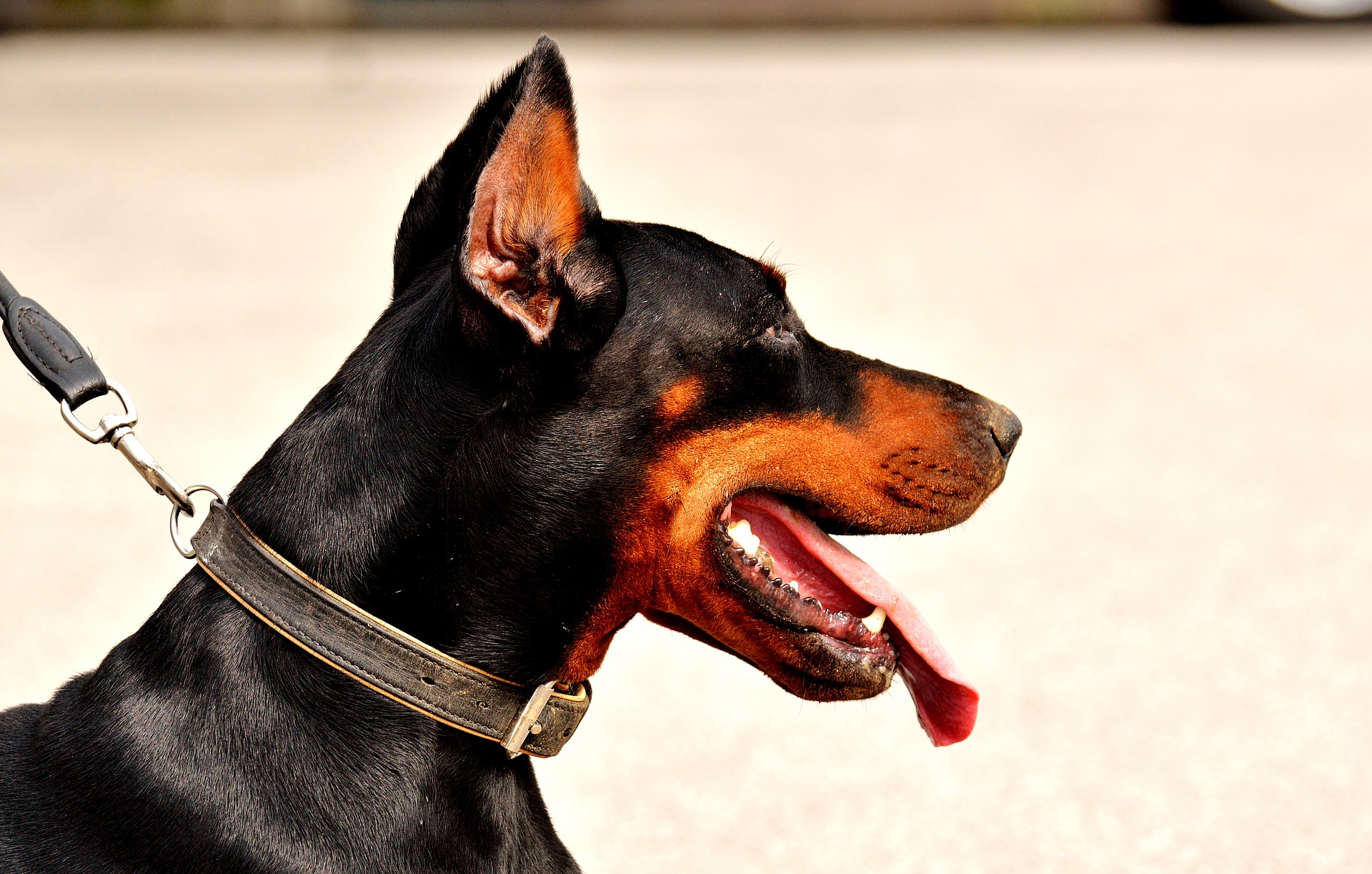How do you walk with your Doberman on leash? By looking at Dobermans’ nature and history, it is for sure that they are stubborn and headstrong dogs. Although they are quick learners, that does not mean that they will quickly get used to restraining. They like to be in control and hence will always walk a few steps ahead of you. Due to this nature of the dogs, you have to control your temper and train them well with patience; to do that, you may have to learn all about their instincts and behavior and then train them accordingly.
Another issue that comes while training them is their size. Doberman is not small or medium-sized dogs whom you can easily control. So, it is better that you read this guide and then start your training. You can not jump directly to make them wear a leash and take them out for a walk. You will have to start the training at home with a few reward sessions. When they get used to this, then you can take them out on public or busy roads. This practice will be for their safety because if they run off or even try to run on a busy road, you will not be able to control them. Any mishap can happen, and to prevent that, your Dobermann should be well trained to walk on a leash and obey your every command.
Before you delve into the proper training of your dog, you need to consider a few things. Try to follow all of these, which is a part of the training, and this will further help you and make those training sessions more manageable.
Bevor you keep on reading check out our Instagram and TikTok Accounts.
Pre-Tips
- Don’t forget to reward:
This action is very important. All you have to do is decide on the treat, your Dobermann loves the most, and every time he does something according to your command, reward him with that treat. You don’t have to give him two or three; one would be enough. This way, he will crave for more and obey your every single command. - Train him with basic manners:
This step is really important as you will teach him who is in charge. You have to build patience in him, and he has to understand that you are the master, and he has to understand and listen to you. It is against their nature, but when trained regularly, they will quickly learn your facial expressions. They like to make their owners happy. Make him wait at the door for you. If you are going out for a walk, he should learn to wait until you first pass out that door. It will take a little time as it is the nature of any animal to move past the door as soon as it opens. This simple practice will make a great difference, and he will learn that you are in charge. - Give him the “sit” command:
You will have to teach him the sit command to help in the leash training session. - Teach him the “release” command:
Just like the sit command, this is also necessary as he can be relaxed after doing something you asked him to do. You can use several words like done, enough, finish, all done, all clear. So, he can understand that now he can relax. - Use a non-extendable leash and collar:
Now, this is important as when the extendable leash is used, your dog will build the habit of pulling, and as he can extend further, he will try to run in the training session, which make it more hectic for you. It is better to use a standard leash with a good hand grip and collar, so he will not be able to pull so hard on the leash from the beginning. Don’t try to buy any fancy collars as they may hurt him, so a normal collar is more than enough.
When you have taught the above things to your dog, feel he is completely ready and listens to you despite his alpha nature, you should move towards the real training steps. But still, keep in mind that your patience is what is required at this stage. Dobermanns are large-sized, stubborn dogs, so deal with them by controlling your temper and losing hope. Once they do get trained in all aspects, they are a gem to have by your side.

Teach your Doberman to understand the leash pressure.
This act requires you to take your dog to the backyard of your house or some place with a fence. This will help as there will be no distractions, and your dog will focus on you.
First, walk with him and then move the leash to one side, this will apply pressure on the dog’s collar, and he will move towards that direction. When he turns in that direction, reward him with a treat and appreciate by patting his back. Move the leash to another direction, and again he will move in that direction. Keep this practice going on for days; when you feel that he has adapted to this practice, move to the next step.
Practice the Heel Position.
This position means that your dog will walk by your side. Not one step forward or one step behind. The dog’s toes should match the level of your toes, and so does his steps. When he stops with you and sits, reward and appreciate him.
You can also allow him to sniff at different things, which will keep his dog instincts on point. But make sure he does not pull the leash; if he does so, you can take a few steps back and make him stop.
Try this practice for a few minutes every day, and then when you are sure that your dog is listening to you, you can move to the next step.
Walk for a short distance.
This practice should be done in places with fewer people, so your dog does not get distracted. Walk your dog in the heel position and make sure to reward him. Hold the treats in your hand so his entire focus will be on your hand. Then make him sit after walking a few steps. Reward him and praise him. This will keep your dog on his toes, and he will listen to you.
Repeat this procedure of walk, sit, reward, and praise.
In case he tries to walk in front of you, do not wait for the leash to pull; stop him right away and then start this procedure again. This whole thing will take some time as your Dobermann will learn your commands and gestures. But again, I would ask you to remain patient as it is just like teaching a child to walk.
Keep on practicing.
At this stage, many people give up on training their Dobermanns. You have to correct him if he does anything wrong because they are in the learning phase, and a teacher has to be patient. They should have the habit of sitting whenever you stop and when they do, give them a treat. If they do not sit, give them a command in a firm voice and give a little upward push by the leash. When he sits, reward him.
Ensure that your dog is fully attentive and distracted by something that brings his attention back. This is very important in public areas.
Now mix all of the above steps and reward him as he follows your lead. Make him turn directions, walk by your side in heel position, make him sit when you stop, and if he does this by himself, then show enthusiasm and pat his back by calling him a good boy. This will cheer your Dobermann, and he will pay more attention to you.
Gradually move towards public areas.
This can only be done when you are sure that your Dobermann is ready to walk in public areas and follow your lead. You can not jump to this as his large size will make it difficult for you to control him if he tries to pull the leash. When you are completely confident, take your dog to a park with a few people and check his behavior with a few distractions. When he behaves normally and with those distractions, still pays attention to you then you can take him on roads or more crowded areas near people. But still, you need to carry his treats in your hand so he will be practicing and having fun at the same time.
Make sure you don’t follow your Doberman lead.
This is very important as at some point, when he walks in front of you or tries to sniff at something and pulls on the leash and you follow him; you are reinforcing the leash pulling habit in him.
This might not seem such a massive problem initially, but it may cause a disturbance in public areas. Whenever your Dobermann tries to walk in front of you, immediately stop and make him sit.
Doberman owners have to be consistent in their behavior and training because if you lose your routine, you will have to start all over again. So, you must keep on training your dogs regularly. Secondly, you have to give Dobermanns the release command and allow them to sniff around. If you do not allow them to do dog things, they might get frustrated. So, make them follow your command but still let them be the dog that they are.



